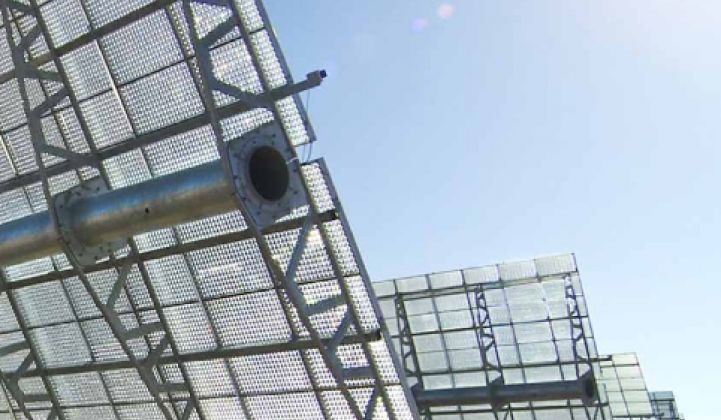When we reported last month that France's Soitec was among the last companies standing in concentrating photovoltaics (CPV), we might have spoken too soon. Reports indicate that Soitec's CPV factory in San Diego is on its last legs and its contract with local San Diego utility SDG&E is suspect.
Filling the factory to capacity depended on a project in Imperial Valley, Calif. with Omaha-based Tenaska Solar Ventures going through. But Tenaska switched to less expensive, less risky technology earlier this year.
Voice of San Diego reports, "The Tenaska deal is now history," and Soitec confirmed that the SDG&E agreements are in jeopardy. According to the Voice report, Clark Crawford of Soitec "was pleading with [CPUC] officials to force Tenaska to use Soitec products in its project."
There appears to be massive miscommunication between SDG&E and Soitec. “SDG&E does not have any contracts with Soitec,” said utility spokesperson Jennifer Ramp. Soitec claims that SDG&E declines to discuss the issue and may let the PPAs terminate.
Then there's the CPV module factory in Rancho Bernardo, which received $25 million in a DOE grant and has produced 5 megawatts of CPV product so far, according to the firm. The 176,000-square-foot factory was to have an annual capacity of 200 megawatts and create 450 jobs. Soitec claims to have invested $200 million in its construction. The $25 million grant was from the DOE's SUNPATH program, which aims to foster a competitive American solar manufacturing base.
A red flag was raised when Gaetan Borgers, the executive VP of Soitec's CPV group, left the French firm to become president of the solar unit at Emirates Capital in August. Another red flag was the recent business and PR mishap that came with Soitec announcing sale of its PPAs to another developer, only to see that deal apparently collapse.
Soitec and Soitec's PR agency have not responded to GTM's inquiries.
SDG&E issued the following statement:
“Since 2011, SDG&E, along with other regional partners, has worked very hard to bring Soitec to San Diego with a focus on helping them be successful. SDG&E has taken unprecedented action to work with Soitec, amending contracts, extending milestone deadlines and seeking additional CPUC approvals over the years so that we could bring additional renewable resources into the San Diego community, but Soitec has historically not been able to meet the extended deadlines and other milestones in the contracts. Earlier this year, Soitec assigned their contracts to third-party developers. Therefore, we no longer have a direct business relationship with Soitec."
The signs are clear -- this deal is toast and the factory is in trouble.
CPV Technology
Soitec builds its own multi-junction semiconductor, high-concentration PV systems, and also helps develop and finance its projects. Soitec's technology allows photovoltaic III-V semiconductor layers to bond together with a minimum of lattice-mismatch drama. Soitec has a 44-megawatt project in Touws River, South Africa still in development and approximately 75 megawatts' worth of CPV projects in the ground.
But CPV competes with silicon-based solar, a losing bet for CPV firms as well as most thin-film solar firms looking to displace silicon. The price to install silicon-based PV has plummeted due to volume and China, but CPV has not participated in this price drop. CPV's reliance on high-precision trackers and high-cost semiconductors has negated its efficiency gains. This information has been available to the people and government of San Diego for years.
CPV has a 0.25 percent global market share of the 40 gigawatts of PV being installed in 2014. That figure comes courtesy of an optimistic forecast of 100 megawatts installed this year. But compared to crystalline silicon, CPV's riskiness in terms of price, reliability and bankability has prevented the technology from achieving commercialization and scale.
We've logged the attrition in the CPV industry and are keeping an eye on the surviving aspirants. SunPower is the only U.S. manufacturer of note. The company claims that its C7 Tracker has up to a 20 percent lower levelized cost of electricity than competing technologies, contending that it provides "the lowest levelized cost of electricity for utility-scale solar power plants available today."
There are other CPV firms: Arzon is the company that remains after the venture capitalists departed from Amonix. Semprius, REhnu, Morgan Solar, Solar Junction, Banyan Energy, Cogenra, SolarSystems, Zytech Solar, Magpower, Ravano Green Powers, Cool Earth Solar and a few other startups are still trying to compete with crystalline silicon.



